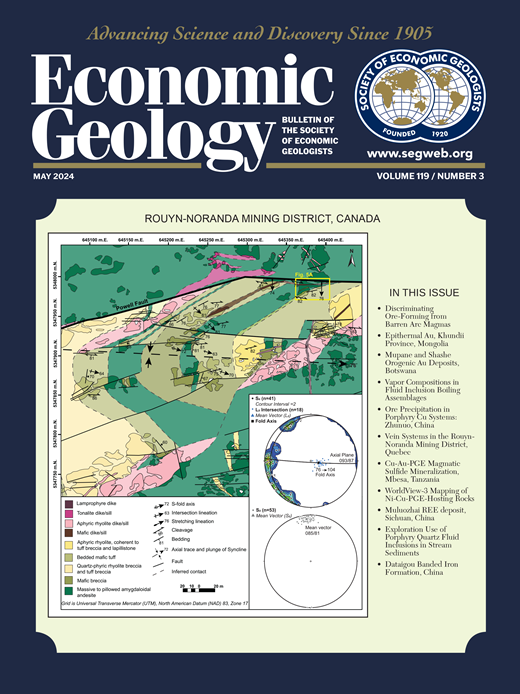热液蚀变和矿化对兄弟火山IODP 376考察岩石古地磁性质的影响
IF 4.9
1区 地球科学
Q1 GEOCHEMISTRY & GEOPHYSICS
引用次数: 1
摘要
海底热液系统的三维海底结构在很大程度上是未知的,特别是在弧火山。这些体系中火山岩的变化使它们的磁性发生了巨大的变化。在这里,我们首次对来自兄弟火山(Kermadec弧)的热液蚀变英安岩定向样品进行了全面的古地磁测量,这些样品是在国际海洋发现计划(IODP)第376次探险期间钻探的。这些数据使我们能够深入了解海底火山岩中磁性矿物的渐进演化,这些矿物受不同类型和程度的热液蚀变的影响,以响应不同的流体温度、化学性质和相关的矿化;从典型的相对低温与海水相互作用的初始绿岩化到受高温、酸性岩浆流体影响的极端蚀变岩石。热液蚀变样品的自然剩余磁化强度(10-4 ~ 10-2 a /m)明显低于未蚀变样品(1-10 a /m),表明原生钛磁铁矿颗粒在热液蚀变过程中被破坏。除了矿化网带附近的一小块区域外,没有观察到与热液蚀变有关的化学残余磁化,这与黄铁矿、金红石、亮绿石等抗磁性和/或顺磁性矿物的广泛形成一致,这些矿物不携带任何自然残余磁化。退磁实验表明,大多数定向样品具有稳定的特征剩余磁化,这是由岩石在海底冷却时形成的残余原生磁性矿物引起的。而部分绿泥化英安岩的磁化率大,Koenigsberger比低,磁顽力极低,与初始溶蚀较小的单畴磁性颗粒一致,表明强烈热液蚀变岩石比初始绿泥化样品在热液体系外围具有更好的古地磁指示作用。新鲜岩石和热液蚀变岩石之间的显著磁性对比,以及在兄弟火山观测到的厚层(>300 m)退磁岩石,证实了磁异常是确定海底弧火山热液系统几何形状的重要地球物理工具的经验结果。本文章由计算机程序翻译,如有差异,请以英文原文为准。
Effects of Hydrothermal Alteration and Mineralization on the Paleomagnetic Properties of Rocks from IODP Expedition 376 at Brothers Volcano
The 3-D subseafloor architecture of submarine hydrothermal systems is largely unknown, particularly at arc volcanoes. The alteration of volcanic rocks in these systems produces dramatic changes in their magnetic properties. Here, we present the first comprehensive study of paleomagnetic measurements from oriented samples of hydrothermally altered dacites from Brothers volcano (Kermadec arc), drilled during International Ocean Discovery Program (IODP) Expedition 376. These data have enabled insight into the progressive evolution of magnetic minerals in subseafloor volcanic rocks affected by variable types and degrees of hydrothermal alteration in response to varying fluid temperatures, chemistry, and associated mineralization; from initial chloritization typical of relatively low-temperature interaction with seawater to extremely altered rocks affected by higher-temperature, very acidic magmatic fluids.
Hydrothermally altered samples show a significant reduction in natural remanent magnetization intensity (10–4 to 10–2 A/m) compared with unaltered samples (1–10 A/m), suggesting that primary titanomagnetite grains are destroyed during the hydrothermal alteration process. Except for a small region in proximity to the mineralized stockwork zone, no chemical remanent magnetization is observed in association with hydrothermal alteration, consistent with the widespread formation of diamagnetic and/or paramagnetic minerals such as pyrite, rutile, and leucoxene, which do not carry any natural remanent magnetization.
Demagnetization experiments show that most of the oriented samples possess a stable characteristic remanent magnetization induced by the residual primary magnetic minerals formed at the time the rocks cooled on the sea floor. Partially chloritized dacites, however, are characterized by large magnetic susceptibilities, low Koenigsberger ratios, and very low magnetic coercivities, consistent with initial dissolution of smaller, singledomain magnetic grains, indicating that intensely hydrothermally altered rocks are better paleomagnetic indicators than initially chloritized samples at the periphery of the hydrothermal systems.
The significant magnetic contrast between fresh and hydrothermally altered rocks, in addition to a thick layer (>300 m) of demagnetized rocks observed at Brothers volcano, confirms the empirical results that magnetic anomalies are important geophysical tools to determine the geometry of hydrothermal systems at submarine arc volcanoes.
求助全文
通过发布文献求助,成功后即可免费获取论文全文。
去求助
来源期刊

Economic Geology
地学-地球化学与地球物理
CiteScore
10.00
自引率
6.90%
发文量
120
审稿时长
6 months
期刊介绍:
The journal, now published semi-quarterly, was first published in 1905 by the Economic Geology Publishing Company (PUBCO), a not-for-profit company established for the purpose of publishing a periodical devoted to economic geology. On the founding of SEG in 1920, a cooperative arrangement between PUBCO and SEG made the journal the official organ of the Society, and PUBCO agreed to carry the Society''s name on the front cover under the heading "Bulletin of the Society of Economic Geologists". PUBCO and SEG continued to operate as cooperating but separate entities until 2001, when the Board of Directors of PUBCO and the Council of SEG, by unanimous consent, approved a formal agreement of merger. The former activities of the PUBCO Board of Directors are now carried out by a Publications Board, a new self-governing unit within SEG.
 求助内容:
求助内容: 应助结果提醒方式:
应助结果提醒方式:


